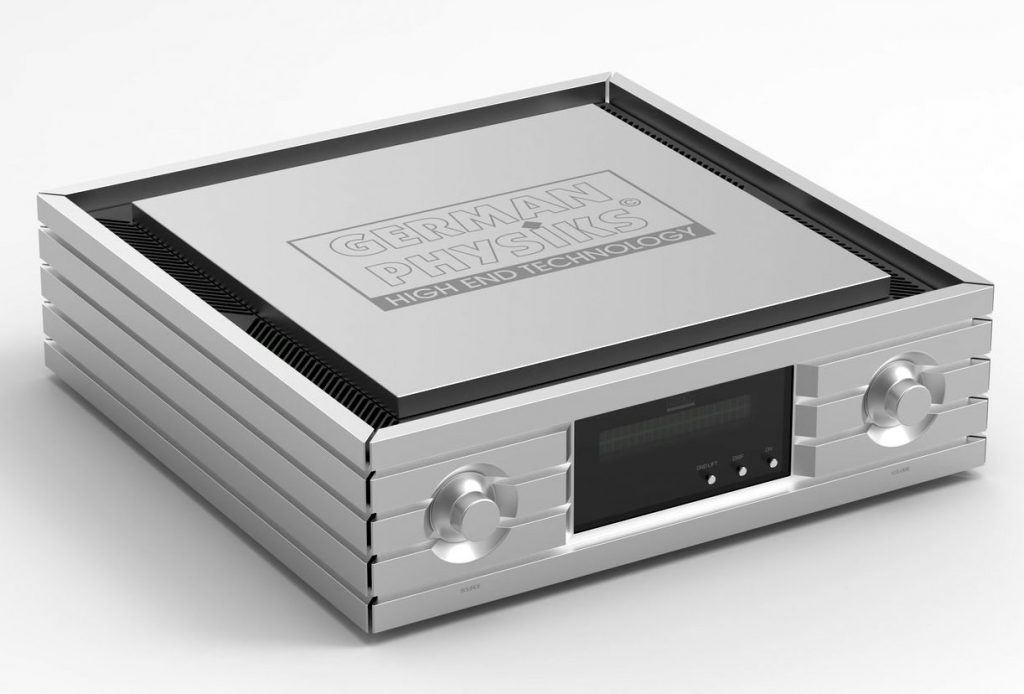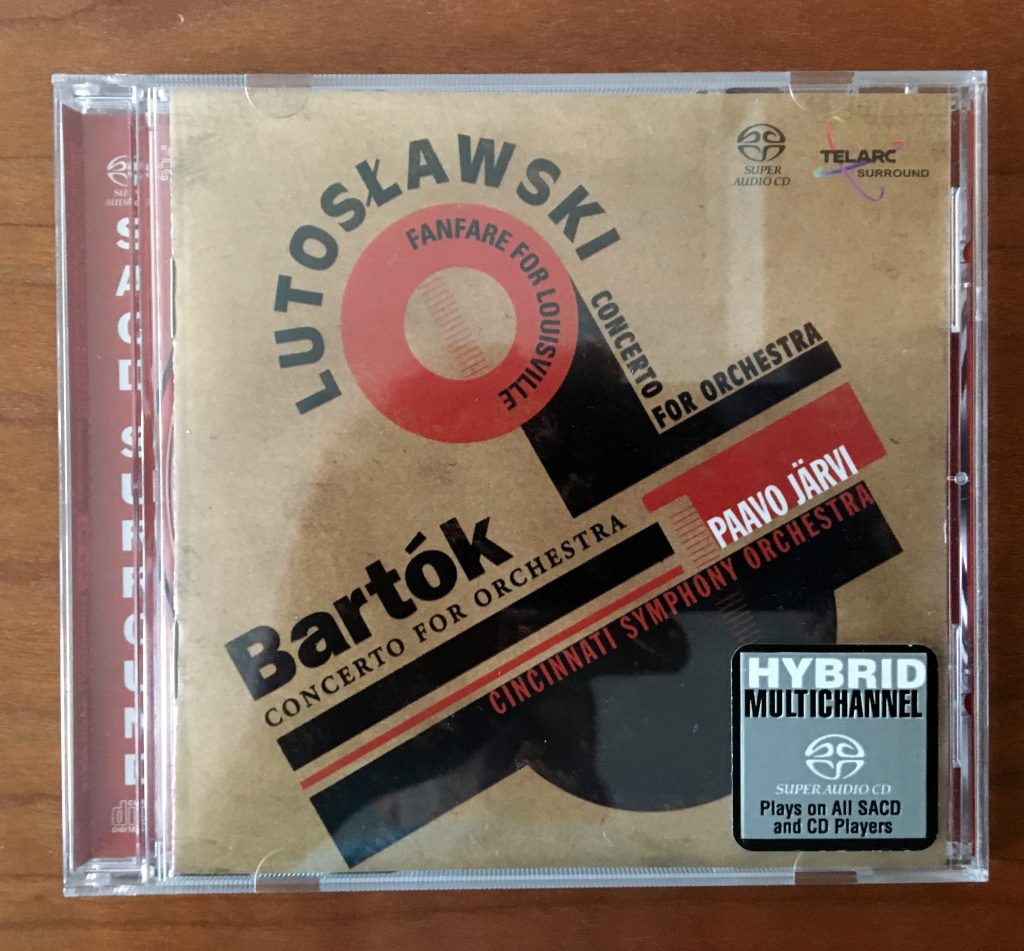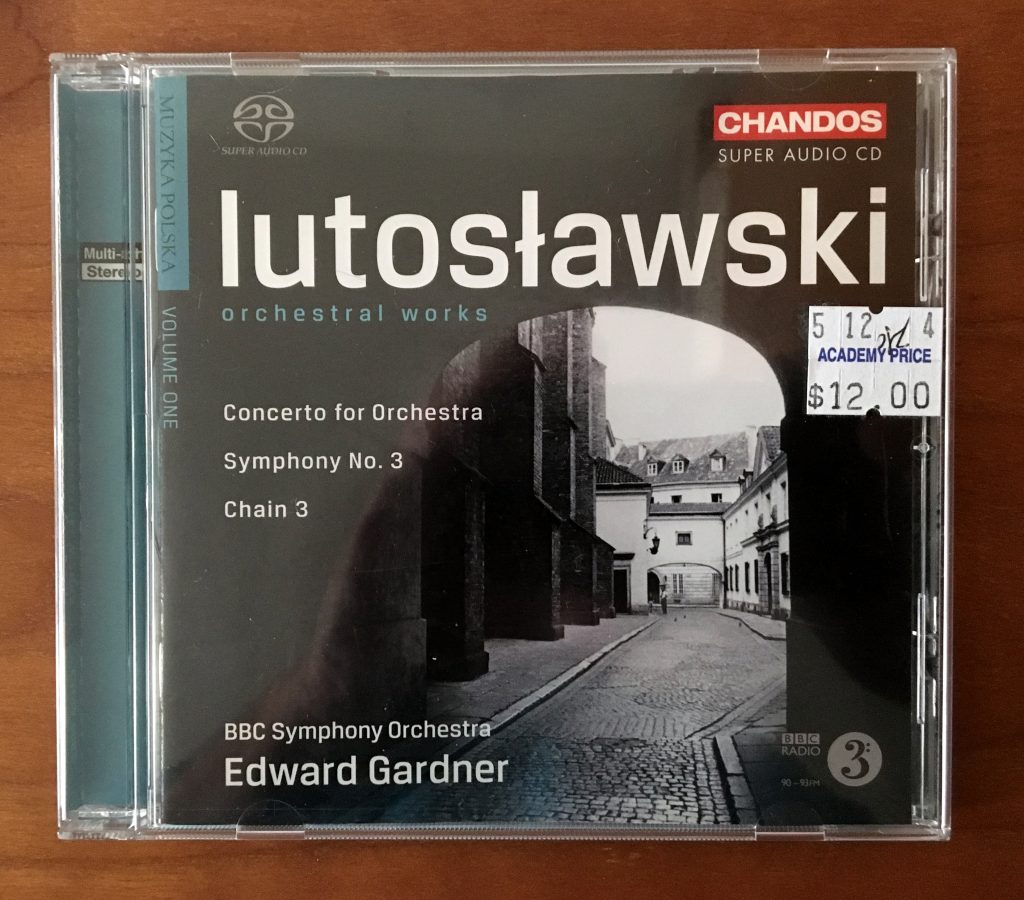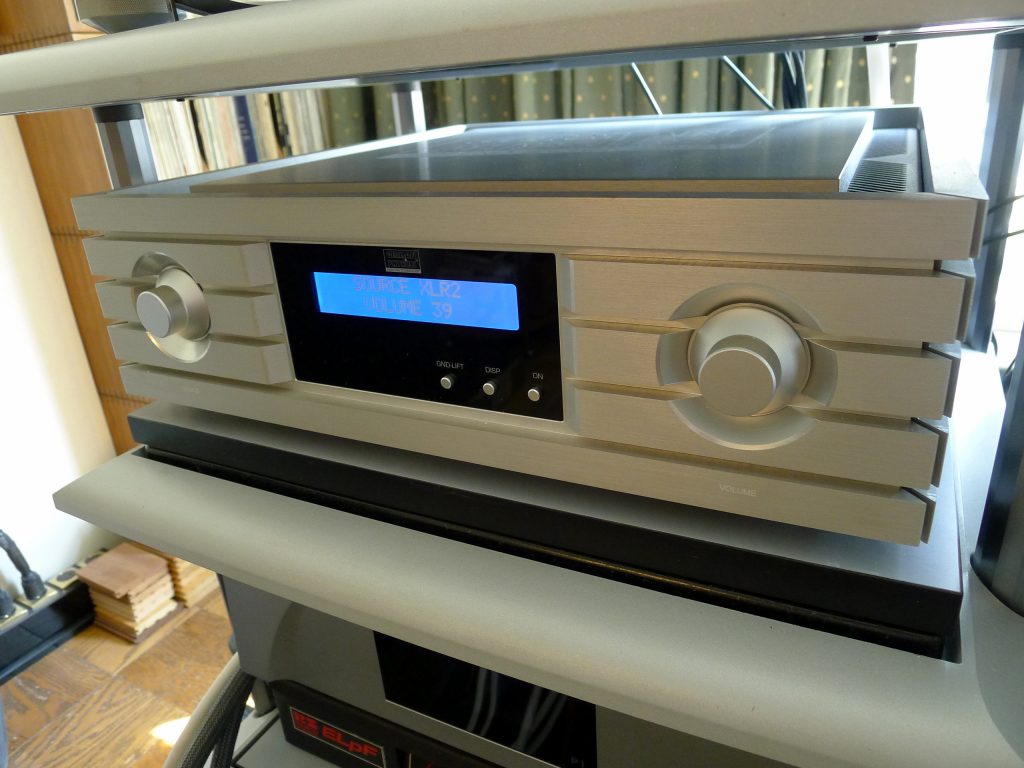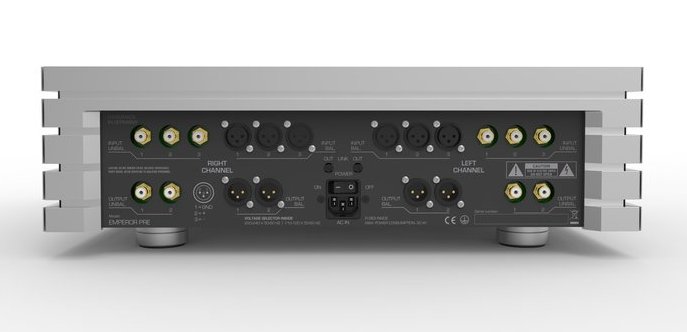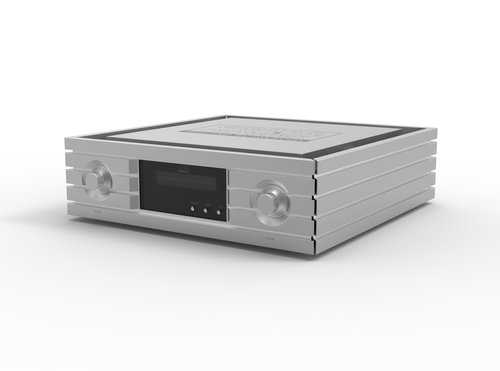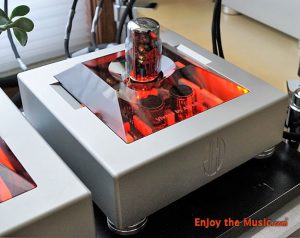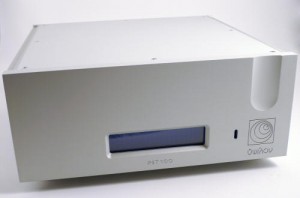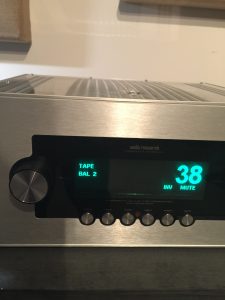At 66 pounds, it took two of us to carefully hoist the new German Physiks Emperor Preamplifier onto my rack. This is the heaviest preamp I've had since the mbl 6010D a decade ago. That was so huge I needed to get height extenders for my TAOC rack. The Emperor is not that big, just slightly bigger than my CH Precision L1 Preamp (which is already larger than the average). At 18½" W x 6⅓" H x 18½" D, the Emperor just fit on the shelf. But why is this thing so heavy? We'll answer that shortly.
Not Your Usual Black or Silver Box
This is one chassis that won't recede into the visual background. The chiseled, louver-like metal-work wrapping around the front and sides creates an impression of masculine solidity and mass. The top cover, with a central panel displaying the German Physiks logo floating on a black metal surrounding grill, makes an even bolder design statement. It's all fabricated from 15mm thick silver anodized slabs. Quite a statement! "Wow! That looks like a small amplifier," was Joseph's impulsive reaction.
Image courtesy Laurence Head
In its way, the louver motif reminds me of the fortress-like US Embassy in Ottawa, Canada, which the locals affectionately nicknamed The Bunker.
The Emperor electronics line is brand new from German Physiks, a company known for speakers. It had its U.S. unveiling at Chicago Axpona 2019, and includes a preamp, stereo amp, monoblocks, integrated amp, and a line of audio wires, with ambitions for a CD player. When the US importer inquired if I had an interest in doing a review, I didn't hesitate.
I normally don't take in gear without a positive appraisal from a trusted source. In this case, I was already acquainted with the speaker line, specifically the HRS-130 and the Borderland ($24,500 and $37,250 respectively, with the optional high-polish finish). Both are two-ways with a downward firing woofer and the German Physiks proprietary, omnidirectional DDD driver covering the range from about 200Hz on up. The speakers impressed me with a huge soundstage—wider and deeper than I get at home—seamless coherency, and a warm, full tone that was immediately ingratiating. I figured whoever had input on the voicing of the speakers would have worked on the electronics as well.
Initial Impression
Joseph brought over a curiosity, the Quartuor de Clarinettes de Geneve (Gallo 30-391). I looked askance at the LP jacket and wondered why? A clarinet quartet? Next, it'll be a tuba quartet. (Now that could be interesting.)
I cued up the LP and in seconds discerned its superior sound quality. The four instruments, E-flat, B-flat, A, and bass clarinets, share obvious affinity as members of the single reed family. Together they comprise an ensemble analogous to a string quartet and, like a good string quartet, where the four instruments align in a continuity of timbres (i.e., the second violin should not sound noticeably different from the first), with continuity from the deepest notes of the bass clarinet to the at times piercing high notes of the E-flat instrument.
The Emperor transitions smoothly across this wide frequency range. While extended on top and bottom, it plays favorites with the midrange, followed by the bass, with the treble coming in a strong third. Tonal shadings were continuous, avoiding any hint of the step-like gradations that you sometimes encounter that leave a mechanical taste. This seamless flow made me think ANALOG (as opposed to how we conceive of digital). You'll find this analogy repeated below in another context. The point is fundamental to the Emperor.
The quartet sits center stage and the instruments blend and overlap, their tones merging into one another. This is not a hyper-precision kind of sound that spotlights instruments into discrete images with sharply drawn borders and brings out chair scrapes or page turns that you never heard before. Those may be present, just not in the foreground. The Emperor's acuity lies in finely drawn tonal shadings and timbral portraits, which help to define and locate each instrument without relying on imaging cues. I had no trouble discerning who was playing and where they were located.
The Emperor places you in a seat approximating mid-hall in a small recital venue. The large images have so much body that some will call it a fat sound, in the positive way that jazz aficionados use the adjective. (Not in the pejorative way audiophiles apply it, as in loose and warm because, while it is a bit warm, rest assured there is nothing loose here. Everything is firm and taut.) Related to that, you'll note the absence of romance or excess bloom.
A Tale of Two Concertos for Orchestra
This was how the Emperor sounded listening to Lutoslawski's ever-popular Concerto for Orchestra, with Paavo Jarvi and the Cincinnati Symphony Orchestra (Telarc SACD 60618).
Switching to Edward Gardner's take with the BBC Symphony Orchestra on Chandos (CHSA 5082), the presentation shifted considerably. The large, full-bodied images went on a diet and slimmed down, their borders firmed up and became discrete, and empty space appeared between them. Nobody would call this a fat sound. And so it went: The Emperor gave insights into the engineering aspects of each source I put on, a testimony to the machine's relatively small footprint and essential neutrality.
The mass loading effect
The physical weight of the Emperor necessitates we discuss mass loading. My CH Precision L1 Preamp weighs 44 pounds, already on the heavy side. The Emperor is half again as heavy. I knew immediately this would impart a significant mass loading effect—and that made me smile, because mass loading has its benefits. A long time ago I discovered a correlation: adding physical mass to a shelf translated into a weightier sound. I believe upping mass lowers the resonance point of the rack (and everything on it). I bought marble slabs for just this purpose a long time ago. I still could use more—everyone wants more weight in their sound, right?
The bulk of the weight in the Emperor preamplifier is concentrated in a pair of huge toroidal transformers in the power supplies for the audio and control sections. Are dual transformers in a preamp unusual? No. A lot of designers do it because anytime you split up an electronic component's functions, you make it easier for it to do its job and potentially enhance performance. Over-sized and this heavy? Yes. I posed the question to several engineers and the consensus opinion was that, beyond a certain point, increasing transformer capacity brought no additional value.
Whether it was the mass loading effect or the over-specification, my suspicion is those twin transformers play a large role in the phenomenal macros. My ear is used to the CH L1 Preamp outfitted with the optional CH X1 Outboard Power Supply (an upgrade available for $17,000). I'm not finding any fall off with the Emperor.
Beyond the wide range, crescendos were handled very comfortably, with no signs of stress. I listen carefully for any breakdown in sound quality at signal peaks. There was none. And it was seamless. The escalation en route to a crescendo transitioned smoothly and made me think once again of analog (vs. digital). Many components sporting powerful dynamics are in a hurry to get to the top and make the move in jerky, ratchet-like gradations. Macros had the added benefit of the Emperor's bottom-heavy frequency response, which threw extra weight and heft into the picture. Stereo separation was also top notch.
Installation
It was easy to get good sound from the Emperor Preamp. For a change, I didn't have to run through my wire inventory or otherwise fiddle around. I connected the same wires I had been using with the CH L1: a Kubala•Sosna Elation! power cord and balanced ICs. But with some audiophile nervosa focus applied to the subject, you can make it even better.
The Emperor proved unusually sensitive to the soundroom environment. For example, when I swapped out my CH L1 preamp, I inadvertently left its X1 external power supply on. After a couple of days, I remembered and shut it down. Surprisingly, the sound changed. The difference was slight, but noticeable. I did some experiments. If I powered up the CH L1/X1 (even though they were out of the signal path), the sound became tighter, more damped. On the jazz piano trio CD I was playing, this was good for the double bass but not for the piano, which sounded like it was in a recording studio with the wood case covered by a blanket and a mike shoved into its belly. With the CH L1/X1 powered off the bass got looser but the piano resonated more, like an acoustic instrument. Now it was like a recital hall. I began to employ this as a useful fine-tuning tweak. Most of the time, I preferred the L1/X1 off because the Emperor brought enough control on its own.
What's going on? The X1 contains a large bank of power supply regulators and capacitors. The changes I'm hearing are consistent with adding (or subtracting) regulation and capacitance. My guess is it's similar to the phenomenon known as back-EMF. A small amount of those commodities kicks back from the X1 along its power cord and gets into the AC line. From there it spreads to other components. Think of it as a form of (useful) powerline pollution. Adding these is usually a good thing, but it depends on what your system needs.
Or check this one out. I used my Fanfare FM Tuner to burn in the Emperor for a few days, and then forgot about it. Sometime later, we were listening and Lynn told me to "take it out, because it always degrades the sound." When I powered it down, sure enough there was a slight improvement. She further requested unplugging the tuners' ICs from the Emperor: another improvement. Amazed at what was happening, I walked over behind the rack and pulled the tuner's power cord, and—yup, once again. These are easier to understand: all could be related to ground potential differences.
Taken to the nth degree of audiophile mindfulness, you would connect only one source at a time to get best performance from the Emperor. This means pulling your phono ICs when you're listening to digital, or disconnecting the digital ICs if you're playing vinyl. And, if you're testing ICs to see which you prefer, don't leave any unused ones connected. It's well-known that wires hanging off a component act like an antenna for noise. What you'll get is a richer, more liquid sound.
The moral of this story is to be cognizant of interactions in the sound room. Don't have anything unnecessary connected. On the other hand, connect any unnecessary stuff if it makes a positive difference. For the dyed-in-the-wool audiophile, it's never as simple as plug-n-play.
Miscellaneous Discussion Points
In operation, the Emperor was flawless and performed without glitches or unexpected events. Clearly, inordinate attention was lavished on this product. Holger Mueller, the owner of the company, sent along the following notes:
- To give the Emperor range a look that was on the same level as its technical performance, we hired the services of one of the best industrial designers in Germany.
- The design team spent hundreds of hours listening to the preamplifier as we evaluated different components and topologies. At one point this resulted in going back and doing a major redesign in order to achieve the level of performance we wanted.
- To keep noise to a minimum, the preamplifier is fully balanced. It is a dual mono design, with great attention paid to the symmetry of the layout. The construction uses an internal steel chassis with a 15mm thick silver anodized aluminum outer case. This provides magnetic screening, together with structural rigidity to minimize the effects of external vibration.
- When we designed the Emperor preamplifier (and indeed the whole Emperor electronics range), we wanted to be able to exploit the exceptional dynamic range of the German Physiks Gaudi and Loreley loudspeakers. The Emperor preamplifier has an exceptional dynamic range of 140dB.
- There are a number of ways to implement a volume control. In the quest for transparency we chose a balanced control; though it is more difficult to implement than a conventional potentiometer, it does not result in tonal changes at different volume levels. In addition, implementing this with a relay-switched resistor network gives far more accurate channel tracking than is possible with a potentiometer.
Conclusion
As I started drafting notes about the German Physiks Emperor Preamplifier, it struck me that I was on repeat mode. Many front-end components priced around $15-20K have come through recently—the Doshi Line Preamp V3.0 and Phono V3.0, the Audionet PAM G2, Lamm L2.1 Reference Preamp, the Merrill Audio Jens Phono. In all those reviews I note the absence of grain, edge, glare, and noise. Discussing these artifacts was useful, say 10 years ago, when they were common. Today's components at this price point routinely escape them; they are no longer an issue. So, going forward, I'm dropping that discussion, if it's only to note their absence.
Another commonality in the group is excellent dynamic range and macro performance. It is notable that these designers chose to use outboard power supplies—with the exception of the German Physiks. I speculated that it achieves superior dynamic performance through other means, as discussed above.
And another: All the units on that list buck today's trend towards modularity, front-end components ready configured to accept DAC, streaming, or Phono modules. The components mentioned above are single purpose. The Emperor Preamp is an analog stereo preamp. That's all it is made to do.
In terms of sonics the Emperor is a hybrid. Certain aspects—its warmth, full body, and holistic feel—harken back. Other aspects—its firm grip, the absence of excess bloom—are very contemporary. Overall, however, in this marketplace with analog, digital, and hybrid designs, the Emperor will not be mistaken for anything but an analog device.
And, wouldn't you know, everything I've said about the Emperor Preamplifier can be comfortably related to German Physiks speakers as well.
Emperor Preamplifier
Retail: $19,750
German Physiks
U.S. Importer
Distinctive Stereo LLC




